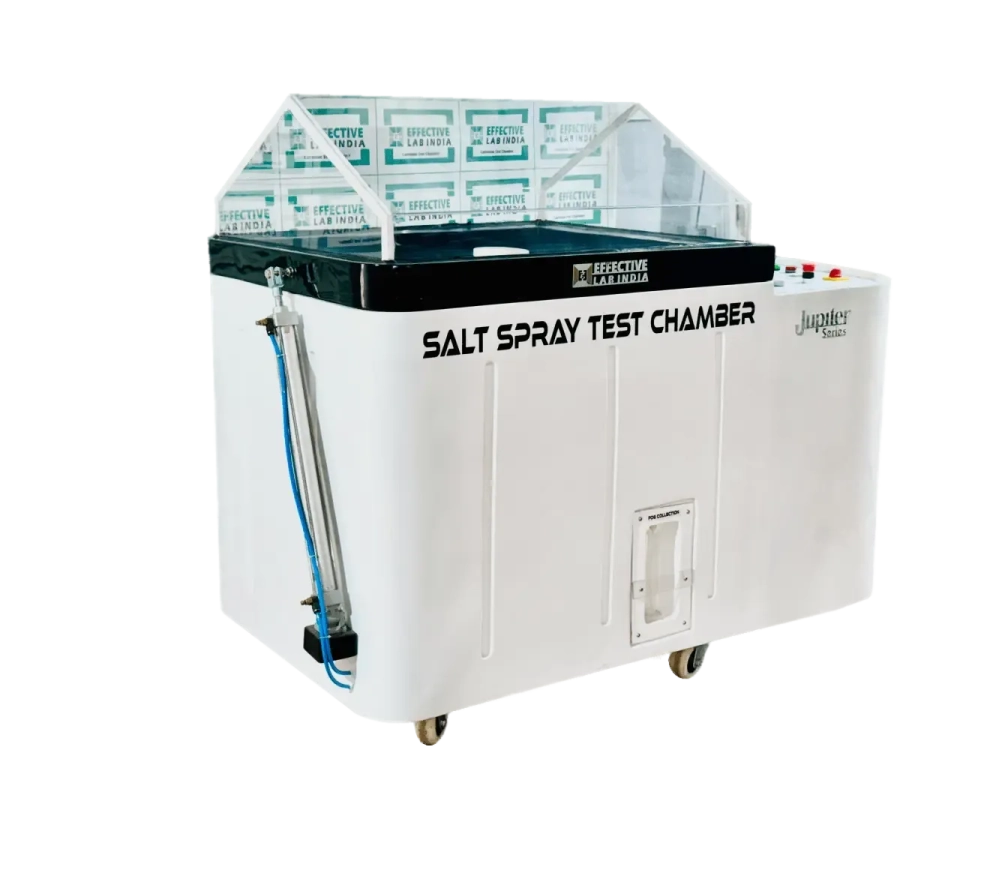Introducing Effective Lab India, a reputable producer of salt spray chambers of superior quality. To assess the corrosion resistance of materials and coatings, a thorough understanding of the salt spray test process is necessary, and this guide attempts to deliver just that. By following these guidelines, You can ensure that your corrosion testing procedure yields precise and reliable findings.
What is a Salt Spray Test?
A standardised test procedure used to evaluate the corrosion resistance of materials and surface coatings is salt spray testing, often called the salt fog test. This test speeds up the rusting and deterioration process by simulating a severe, corrosive environment. It also offers important information about how long the tested specimens will last.
Why Conduct a Salt Spray Test?
- Quality Control: Make sure your goods live up to consumer and industry expectations.
- Product Development: Assess how well-suited new coatings and materials are to stave off corrosion.
- Comparison: Examine how various materials and coatings perform in the same settings.
Step-by-Step Guide to the Salt Spray Test Procedure
Step 1: Get ready
Choose Specimens: Select the coated samples or materials that you wish to evaluate. Make sure they are uncontaminated and spotless.
Examine the Equipment: Check that the salt spray chamber on your device is operating properly. Inspect for leaks, appropriate ventilation, and the presence of salt solution.
Get the Salt Solution Ready: The usual solution of sodium chloride (NaCl) is 5%. To make the solution, dissolve 5 grammes of NaCl in 95 millilitres of distilled water.
Step 2: Chamber Configuration
Put Water in the Reservoir: Fill the reservoir of the chamber with the prepared salt solution. Make sure the level of the solution is adequate for the whole test.
Modify the temperature: Preheat the chamber to 35°C (95°F), as recommended by the majority of test standards.
Where to Find Specimens: Make sure the test specimens are arranged in the room so that they don’t come into contact with the walls or one another. This enables consistent exposure to the saline mist.
Step 3: Starting the Examination
Launch the Chamber: To begin the salt spray test, turn on the chamber. The salt solution will be produced in the chamber and will constantly settle as a fine mist on the specimens.
Keep watch on conditions: Make sure the salt solution is being atomized appropriately and that the chamber is kept at the proper temperature by checking it regularly.
Step 4: Length of Test Duration
Standard Test Duration: Depending on the content and the standards you are adhering to, the test’s length may change. The most common lengths are 48, 96, 168, and 24 hours.
Periodic Inspections: To look for any indications of corrosion, conduct periodic inspections without causing any disruption to the test environment.
Step 5: Testing Out the Results
Put an end to the chamber: Once the designated test time has elapsed, switch off the chamber and remove the specimens with caution.
Rinse Specimens: Specimens should be rinsed with distilled water to get rid of any salt buildup.
Dry Specimens: To expedite the drying process, utilise compressed air or let the specimens air dry naturally.
Step 6: Assessment
Visual Inspection: Look for any rust, pitting, blistering, or other corrosion-related symptoms on the specimens.
Document Results: Keep a record of the findings, indicating the kind and degree of corrosion found on each sample.
Comparative Analysis: To assess how well the materials or coatings work, compare the outcomes to those of control samples or earlier experiments.
Why Choose Effective Lab India’s Salt Spray Chamber
As a leading producer of premium salt spray chambers made to satisfy exacting testing requirements in a range of industries, Effective Lab India has made a name for itself. The “salt spray chamber” from Effective Lab India is a great option if you need to test for corrosion for the following reasons:

Superior Accuracy and Handling
Precision engineering and premium materials are used in the construction of our salt spray testing chambers to guarantee precise and reliable test results. Because the chambers are made to precisely replicate corrosive conditions, they may produce trustworthy data that can be used to evaluate the lifetime and durability of materials.
Advanced Features–
- Various grades of metal can be easily tested.
- HMI-based Display.
- For an effective mode of operation, digital controls are provided.
- The results of testing are highly accurate.
- It is structured with strong rigged material for effective testing.
- Data management is easy which allows the machine to function smoothly.
- Designed in compatibility with industrial standards.
- Timer functions which provide results accuracy.
- Specific temperatures can be set for testing.
Personalisation Choices
We are aware that many businesses have particular needs when it comes to testing. To better meet your unique demands, we provide customisation options for our salt spray testing chambers. We can offer a solution that precisely matches your needs, whether they include a certain size, extra functionality, or testing standards.
Compliance with International Standards
ASTM B117, ISO 9227, JIS Z 2371, and other international standards are all met by the design of our salt spray chambers. By ensuring that your test findings are acknowledged and recognised worldwide, you may more easily comply with legal obligations and industry standards.
In summary
An essential first step in guaranteeing the robustness and calibre of materials and coatings is to perform a salt spray test. You may produce dependable and reproducible outcomes by following this step-by-step guidance, which will assist you in making well-informed judgements on quality control and product development.
At Effective Lab India, we’re committed to meeting all of your corrosion testing needs by offering the best salt spray chambers and all-encompassing assistance. Get in touch with us right now to find out more about our offerings.













